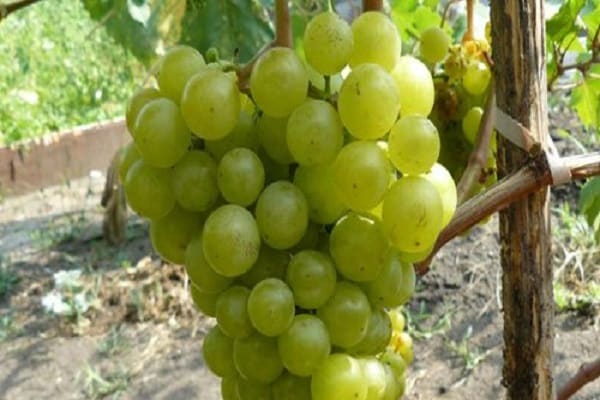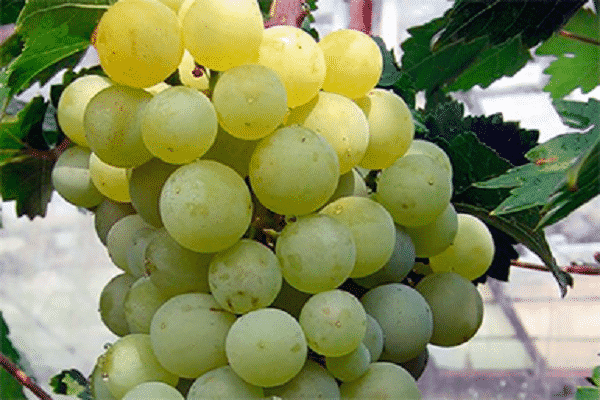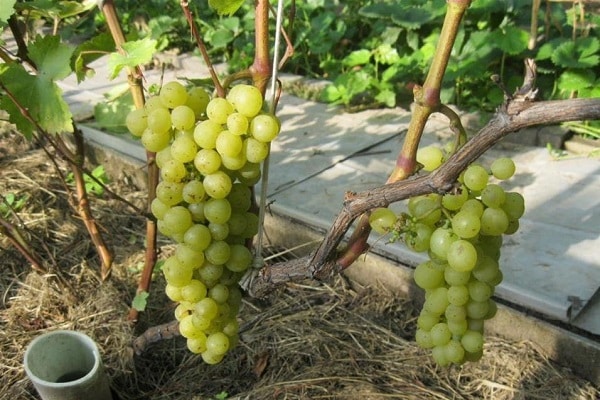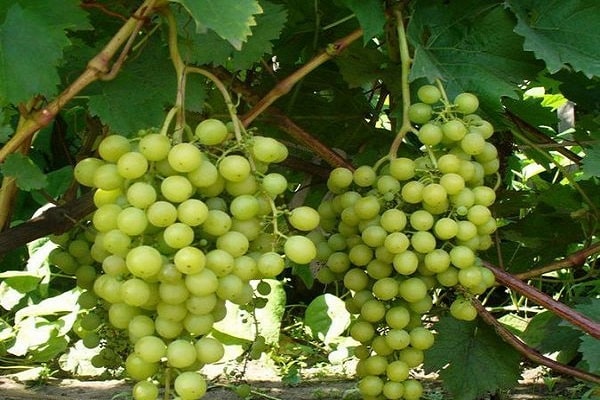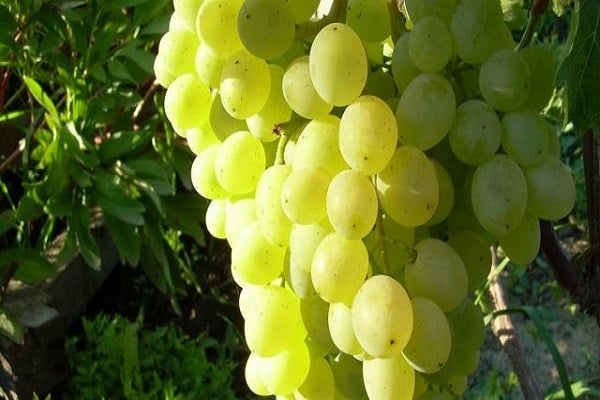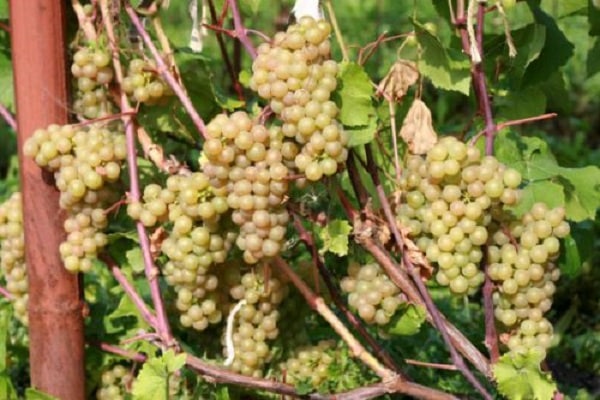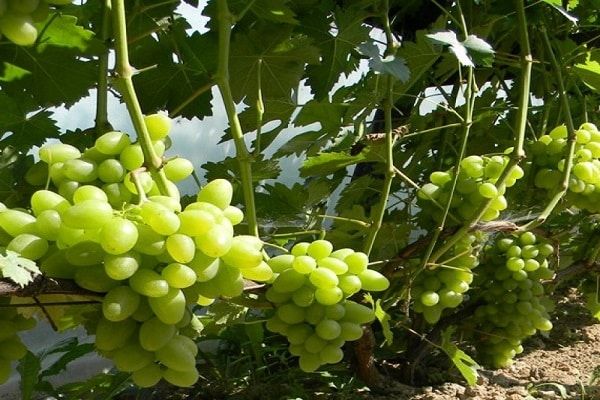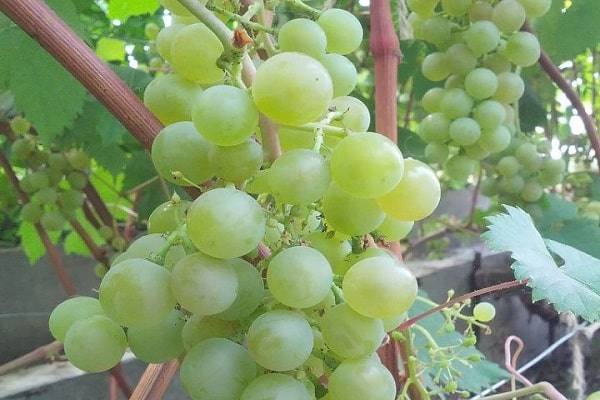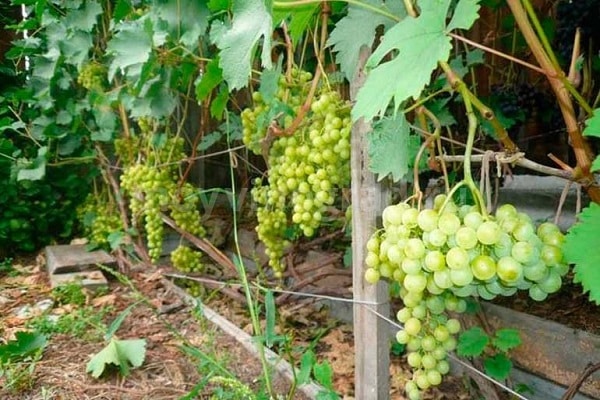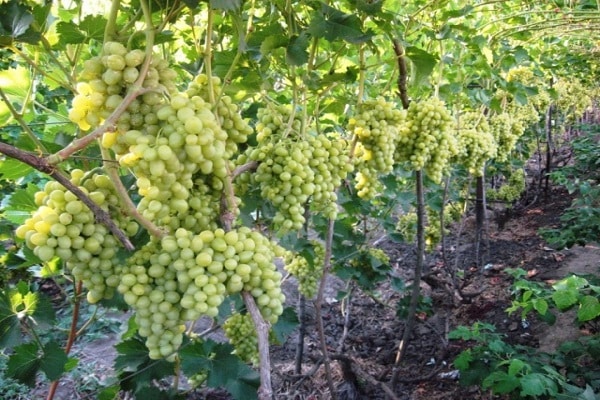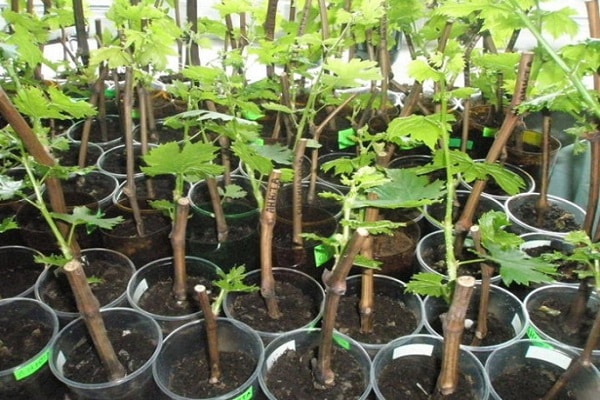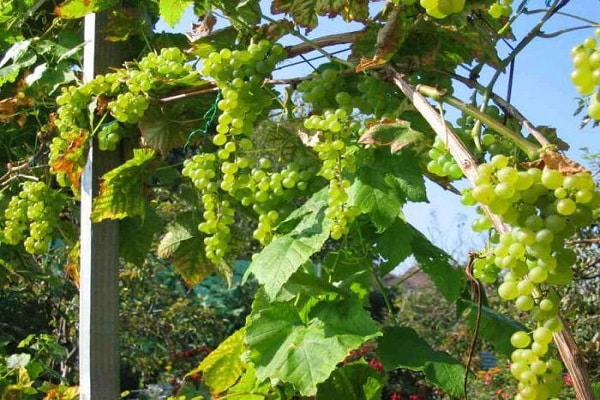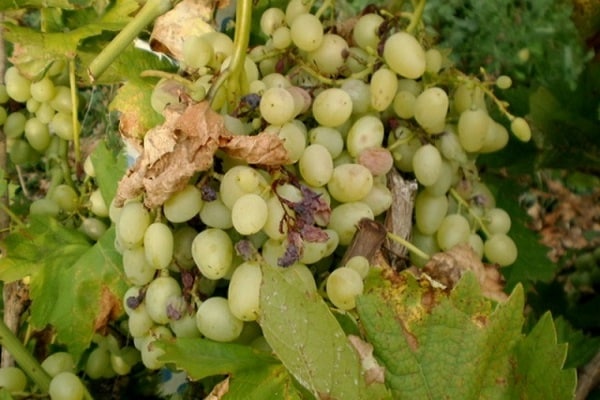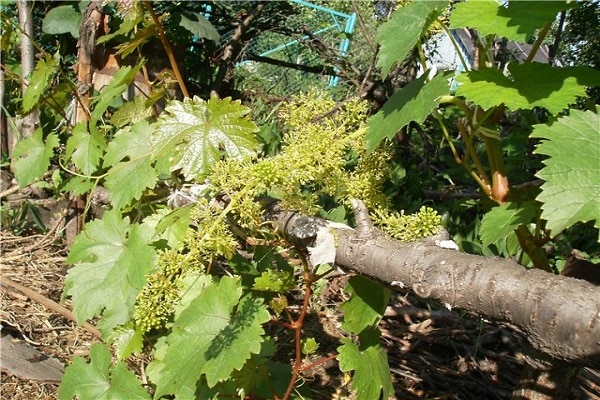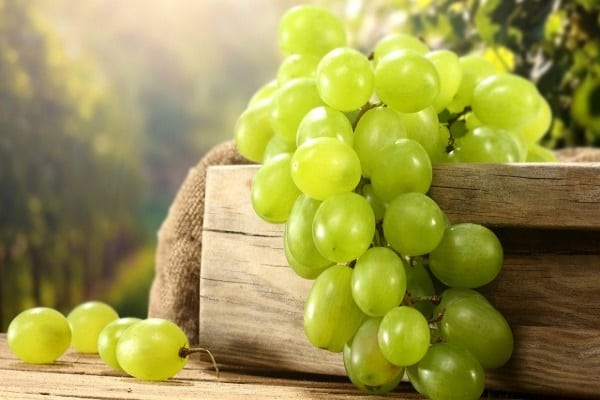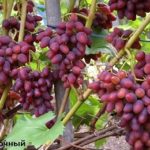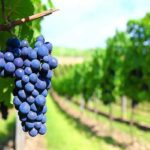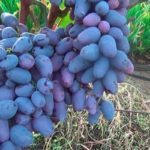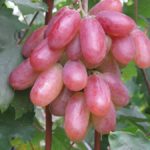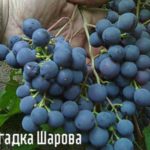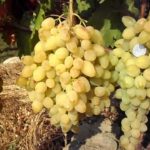There is a wide variety of grape varieties on the horticultural market. Many gardeners do not want to experiment and traditionally give preference to crops that were bred a long time ago and have proven their excellent qualities when grown for many years. One of these is the grape called Tukay, which has established itself as a winter-hardy, unpretentious plant.
- Description of the variety Tukai
- Breeding and origin
- Morphology of the bush
- Bushes
- Bunches
- Berries
- Positive and negative properties of the variety
- What are grapes characterized by?
- Productivity
- Ripening time
- Diseases
- Mildew
- Oidium
- Other
- Frost resistance
- Where can I grow
- Description of bunches and berries
- Disembarkation
- How to choose seedlings
- When can it be planted?
- Choosing a plot of land
- Soil preparation
- Digging a hole
- How to land
- Growing and care
- Pruning and grafting of vines
- Irrigation and fertilization
- Prevention and protection from diseases and pests
- Ways to reproduce
- Preparing for winter
- Harvest and winemaking
Description of the variety Tukai
Tukay grapes are considered an early ripening table grape variety. It is suitable both for fresh consumption and as a raw material for the preparation of preserves and wine.
Breeding and origin
The appearance of the Tukai grape variety is associated with the name of the scientist Ya. I. Potapenko. The goal of his many years of work was the desire to obtain a variety that could be grown in Russian regions with a cold climate. The results of crossing Pearl Saba and Yakdon turned out to be unique, and a new variety was developed, characterized by excellent winter hardiness qualities.
Morphology of the bush
When choosing a grape variety, gardeners first pay attention to the growth characteristics of the plant and the distinctive qualities of fruiting.
Bushes
The leaves are light green in color, have a five-lobed shape, and are slightly dissected.
Bunches
Clusters in the form of cylinders do not differ in significant density. Depending on the growing region, their weight may vary. On average, the weight of one bunch reaches 800 g.
Berries
The weight of the berries varies from 3 to 5 g. The juicy pulp has a pleasant nutmeg flavor. The sugar content in the fruit is 17-19%, acid - 7 g/l. The dense skin allows the berries to withstand difficult transportation conditions.
Positive and negative properties of the variety
Many gardeners talk about the unpretentiousness of cultivation, and even novice gardeners achieve good yields. An undoubted advantage is the winter hardiness of the plant. The bunches are able to stay on the vine for a long time without losing their external and taste qualities. The benefits of Tukay grapes include:
- stability of high yields;
- unpretentiousness;
- formation of flowers of both sexes;
- ability to withstand difficult transportation conditions;
- versatility of use.
The plant's unpretentiousness to soil expands the possibilities for planting. The disadvantage is considered to be insufficient resistance to mildew and oidium. When the temperature rises to +35 0C plant growth slows down and yield decreases.
What are grapes characterized by?
The strengths of the variety are high yields and their stability. The plant makes it possible to obtain tasty fruits in a short time that can be stored for a long time.
Productivity
16-20 kg are removed from one bush. The first harvest is harvested in the 2-3rd year.
Ripening time
Tukai has one of the shortest harvest times. Berries can be harvested 90-100 days after the start of flowering. In cold regions, full ripening is facilitated by the quality of the plant's winter hardiness. The arrival of the first frost is not a critical factor for the plant.
Diseases
The variety is resistant to gray rot. The weak point of the plant is its susceptibility to mildew and oidium.
Mildew
Mildew is one of the most common grape diseases. When infected, an ashy coating appears on the lower part of the leaf blades. Then it turns brown, the leaves begin to dry out and fall off. For prevention, the following measures are taken:
- cover the trunk area with mulch;
- apply nitrogen fertilizers without overusing fertilizing;
- thin out and trim bushes;
- periodically spray ash under the bushes.
If diseased shoots are found, they should be removed and liquidated.
Oidium
When infected, an ashen-colored coating forms on the leaves. An unpleasant odor begins to emanate from the plant, reminiscent of rotting rotten fish. The inflorescences begin to dry out, and the berries suffer from cracking. To combat the disease, spray with a solution of vitriol at a concentration of 3%.
Other
The variety is resistant to most types of grape diseases, with the exception of mildew and oidium. It can be affected by gray rot due to excessive moisture, high humidity or excessive thickening of plantings.
Timely pruning and protecting berries from wasps, ants, aphids and birds will help prevent diseases.
Frost resistance
The selection characteristics of the grapes indicate the ability of the variety to withstand temperatures down to -25 0C.
Where can I grow
Excellent winter hardiness qualities make it possible to grow Tukai not only in the south of Russia. The plant's unpretentiousness and ability to survive at low temperatures make it possible to form grape plantings in the central part of the country and in the north-west. Good results are obtained in Siberia, the Urals and the Altai Territory.
Description of bunches and berries
The berries are formed in cylindrical clusters. They have an average density and, depending on the growing region, can reach different weights.
Disembarkation
The quality and quantity of the future harvest directly depends on the correctly selected seedling and compliance with the rules of care.
How to choose seedlings
Grape seedlings should be purchased in specialized places or verified sales points. When purchasing, you should pay attention to the integrity of the stem part and the absence of defects on it.Root shoots must be flexible, elastic, and not damaged. Their color should be light; darkening indicates putrefactive processes.
When can it be planted?
Planting times vary by region. In the middle zone, work begins at the end of May, when the threat of frost has passed and the soil is sufficiently warmed up. Planting in the autumn is acceptable; in this case, the plantings are formed in September so that the plant has time to take root before the weather gets colder.
Choosing a plot of land
Tukai grapes are unpretentious to grow, but require light. You should not choose an overly wet, swampy or saline area for planting. The ideal territory would be limestone, loam, and sandstone. The place should be sunny and protected from the wind. When planting near a building, it is required to make a retreat from the foundation of at least 1.5 m.
Soil preparation
The area for planting grapes is prepared in advance. To do this, deep plowing is done and weeds are removed. Digging of the hole begins 2 weeks before planting. To backfill, you will need to prepare nutrient soil. To do this, mix humus, black soil and sand in equal parts. To increase the nutritional value of the soil, add ash, potassium salt and superphosphate.
Digging a hole
There are generally accepted standards for forming a pit for planting grapes. It is necessary to provide a depth of 85-90 cm, a width of 70-80 cm. A layer of black soil and clay is formed at the bottom, on which drainage is placed.
How to land
24 hours before planting, the root system of the grapes is soaked in a growth stimulator. When planting, it is important to ensure that the 2 eyes are just above the level of the edge of the dug hole. The root shoots are evenly straightened and carefully covered with nutritious soil.Immediately after planting, the seedling is watered abundantly and provided with support, after which it is cut into 3 leaves.
Growing and care
Tukay grapes are undemanding in care. It needs timely watering and fertilizing. It is necessary to carry out preventive spraying and timely pruning.
Pruning and grafting of vines
Tukay is a grape variety that is characterized by abundant growth, so pruning of shoots is necessary for the plant. If the bushes are overloaded, the berries will become crushed and the taste will deteriorate. The foliage from below should be completely removed, which will help prevent sunburn of the upper part of the vines. Pruning is carried out in the spring, after which no more than 45 eyes should remain on the tree. If the grape plant grows excessively during the growing season, side shoots are removed.
In areas with cold climates, it is recommended to graft onto winter-hardy rootstocks. These include varieties Northern, Alpha, Batur.
Irrigation and fertilization
The plant requires watering and irrigation if there is insufficient natural precipitation. Overmoistening negatively affects the health of grape bushes, as this causes rotting of the roots. When watering, 20 liters of water is enough for one plant. In the spring, moisture-recharging irrigation is carried out to stimulate better plant growth; in the fall, the volumes are reduced to prevent bud release.
Prevention and protection from diseases and pests
In order to prevent diseases of grapes, preventive spraying is carried out with Bordeaux mixture and copper sulfate solution. If necessary, use targeted drugs, following the manufacturer's recommendations.
Feeding with mineral complexes will help increase plant resistance.The first is done a month before the start of the flowering period. In spring, manure or rotted compost is added to the soil. Before the grapes bloom, the soil is enriched with nitrogen fertilizers, which promotes better formation of green mass. Phosphorus and potassium fertilizers applied at the time of ovary formation will help improve the formation of bunches and the taste of fruits.
Ways to reproduce
Grapes are propagated by cuttings or rootstocks are formed with other grape varieties. Properly trimmed parts will quickly take root, so, as a rule, there are no difficulties with propagation. It is important to choose a strong, healthy shoot without signs of damage. The upper parts of the plant are not suitable for cuttings.
Preparing for winter
Tukay grapes require shelter in regions with cold frosty winters. Work begins after the plant has completely shed its leaves and the temperature has dropped to +5 0C. To prevent the appearance of fungal diseases, the vines are sprayed with a solution of copper sulfate. Next, the shoots are cut and bent to the ground, placing them in pre-dug trenches.
Insulation is formed on top using dry grass, soil, spruce branches, branches or protective material for these purposes.
Harvest and winemaking
Due to the early ripening period, the first bunches of grapes in warm regions are harvested at the end of July. Berries are characterized by the ability to be stored for a long time at temperatures from +1 0C to +8 0C. According to the tasting qualities, the grapes were given a score of 9 points. The variety belongs to the table dessert species, but is often used for making wine.

